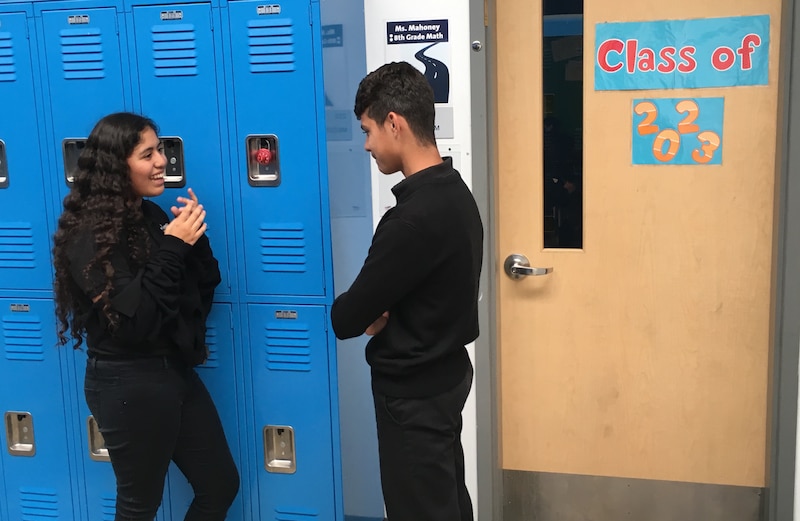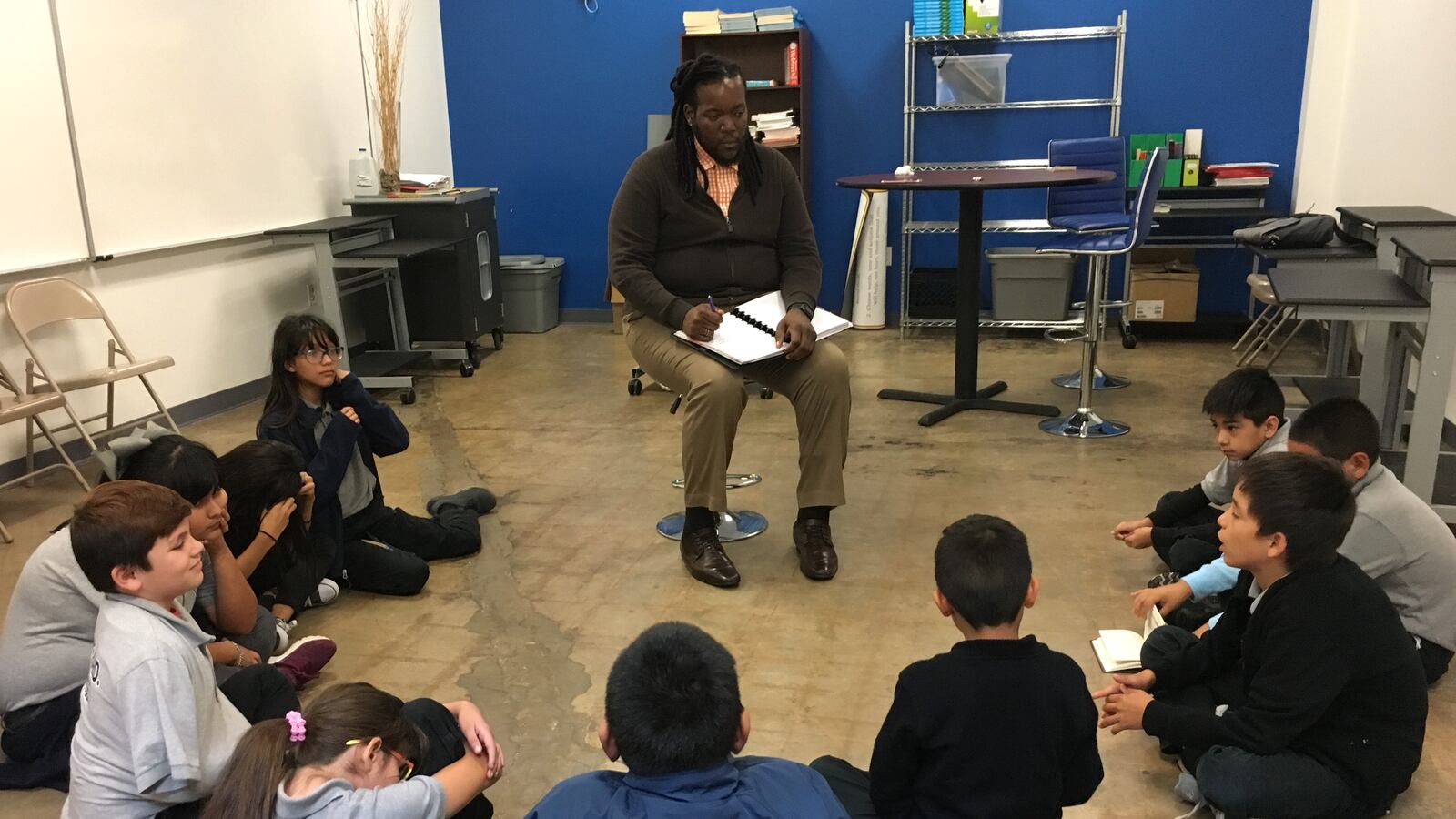It was the second meeting of a group meant to defuse conflicts at KIPP Camino, and there was plenty to defuse.
Whether a certain K-pop band was good or bad, who was friends with whom — it was all causing fights, sometimes with profanity thrown in. Students sitting in a circle took turns explaining what had gone wrong, and it quickly became obvious that one student was the common denominator.
“How did hearing that make you feel?” the school’s dean of culture, Curtis Bailey, asked her.
“Guilty,” she said.
“So what do you think can be done to repair the situation?” Bailey prompted.
“To say sorry and to never do it again,” she said.
Bailey surveyed the scene with a sense of pride: The previous week, all 10 students in the group were caught up in conflict, and it took nearly an hour to sort through the disagreements. This time, they reached a conclusion in 30 minutes.
“We’re starting to whittle down what and who is at the heart of the conflicts,” Bailey said. It was a start.
The activity was part of the San Antonio KIPP school’s efforts to reduce suspensions by adopting “restorative justice” practices that aim to help students rethink and ultimately change their behavior. Inspired by changes in Bay Area KIPP schools nearly a decade ago, changes are underway at dozens of KIPP schools across the country. The initiatives are reshaping schools across the country’s largest nonprofit charter network, which was an early emblem of the “no excuses” movement that called for strict discipline to achieve academic gains.
KIPP is far from alone in reconsidering punitive discipline practices. Amid a growing awareness that harsh discipline can alienate students and could push them off track to graduate, many districts and networks have charged schools with reducing suspensions.
But unlike places where that charge has come via a top-down decree, KIPP is allowing each of its 32 local networks to decide how to make the shift. In some places, the transition happened quickly, while others have plans that will take years to roll out; a few places aren’t prioritizing restorative justice, choosing a different strategy altogether.
Network officials say patience is necessary if the changes are to gain the support they need to make a difference for students. But the strategy comes with costs: Some KIPP schools continue to suspend students at a high rate, while other school leaders say they’re no longer able to solely prioritize academics.
“We’re in the middle of a conversation as a network,” said Rich Buery, KIPP’s chief of policy and public affairs. “Some folks are far along in the process, and others are just starting, so we are still learning. … But we as a network are committed to examining our practices and that is what we are doing. This is not going to start in the national office. This one is going to have to start in the schools.”
In San Antonio, schools are making gains, but with tradeoffs
Bailey’s school offers one example of how KIPP’s evolution is playing out locally.
The school began reconsidering its approach to discipline in 2013, in part because it wasn’t getting the academic results it wanted. The school — where 96 percent of students are Latino and 89 percent are from low-income families — was on the brink of being labeled by the state as failing academically.
Then-assistant principal Juan Juarez said he thought suspensions were helping students learn about the consequences of their actions. When he analyzed discipline data at the end of that year, though, he realized that he was suspending the same students over and over.
“It was not acceptable that these dozen or so students were missing school and jeopardizing their academic potential due to behavior issues,” he said. “I knew we could do better.”
The school started small, introducing the new policies in fifth grade. When Juarez became the principal in 2015, he restructured the staff, building a team to help supplement the school’s restorative justice efforts that included Bailey and a social worker. That social worker represented a tradeoff: the alternative, he recalled, was another math specialist.
“Sometimes you have to prioritize the school culture over academics,” Juarez said. And they’re obviously intertwined, he said, with discipline issues getting in the way of students’ academic goals.
It took two years for the whole school to use restorative discipline. Suspensions fell from 731 two years ago to 451, a 38 percent drop; the campus also earned what would be a B+ under the state’s new accountability system.
Juarez is now helping train others at the six other KIPP schools in San Antonio, which are introducing the policies now. Bailey, who started at KIPP Camino as a math teacher before moving to his behavioral specialist position, says he sees the results at that school daily.
At the end of the recent circle he oversaw with the 10 students, two students agreed to sign contracts agreeing to corrective behavior. Another two students, the nucleus of the group’s conflict, signed up for a more intimate circle.

In Denver, using local donations to build staff
Time helps, but so does money when it comes to introducing restorative techniques.
Kimberlee Sia, CEO of KIPP Colorado Schools, said a $100,000 grant from area donors has been crucial. The local network used that money to hire restorative justice coordinators to expand the work beyond a pilot at one middle school to all six area campuses. The network now includes those positions in annual campus budgets.
At KIPP Northeast Denver Middle School, the first campus to use the techniques across all grades, suspensions fell from 99 to 31 over the past two school years. Meanwhile, another middle school in the network, KIPP Sunshine Peak Academy, saw them increase from 30 to 50 in the same time period, and is just beginning to introduce new policies.
At Northeast Denver Middle School, the school has tried to normalize the kind of circle used after a discipline incident by holding discussion circles for students during their morning advisory period.
“The circles can revolve around a challenge in the community, like a tragedy involving death, or that a house burned down, as way of creating a space for students to discuss what that means to them, in a social-emotional learning capacity,” Sia said. “We’ve learned it’s best to not have students’ initial interaction with restorative justice to be when they have been told they did something wrong.”
In Baltimore, change inspired by local tragedy
At KIPP Harmony Academy, principal Natalia Walter Adamson said her school’s change began as teachers looked for ways to help their elementary schoolers after the death of Freddie Gray in police custody in 2015.
“We could see the trauma in our students’ faces and hear it from what they said they were seeing on TV, or in their neighborhoods, and started to reexamine what are we doing when it comes to supporting them, especially through a racial equity lens,” Walter Adamson said.
Unlike Camino, where educators focus on intervening in conflicts between parties, Harmony’s teachers use classroom-wide circles to get students talking.
In Baltimore, suspensions at the Harmony campus have fallen by over 50 percent over the last two school years, from 229 to 103. KIPP’s other school in the Baltimore area, the neighboring middle school, has yet to adopt new policies, though network officials say it has shown interest.
In the Bay Area, phasing in change
In the Bay Area, which pioneered using restorative justice techniques, new KIPP schools use them from the get-go. Older campuses get a a four-year implementation plan, said Alexei Greig, the region’s head of school culture. Year one focuses on studying the data, then a year is spent training teachers. In the third year, an entire school adopts the practices, which are finessed in year four.
“We actually think this is now the best approach,” Greig said. “You can try to go by grade level, but if it’s not integrated well enough, then you wind up with pockets of success here and there that can lead to inconsistencies.”
KIPP officials credit the changes with helping cut down suspension rates, which have fallen from 8 percent of all students being suspended in 2013 to about 4 percent last school year.
Across the country, moving ahead
Research about restorative justice techniques is limited. There isn’t a critical mass of conclusive research showing that their use leads to better academic or other outcomes for students.
The scattershot approach that KIPP is using — four specialized staffers in some schools, none in others, for example — is helpful for understanding why, according to James Sadler, a research fellow at the University of North Carolina – Chapel Hill studying restorative practices at no-excuses charter schools. The practices can look really different from place to place.
What does exist, Sadler said, “Is enough qualitative research studying teacher voice that says it does seem to work, in at least lowering suspension rates, when there is buy-in from them.”
“The one concern I’ve heard is that teachers do feel at times they are losing control of their classrooms when this directive may come from a principal down,” he said, pointing to the problems Los Angeles faced after the district pushed schools to change. “Even if not from central office — it’s enough to dim some of the buy-in needed in the long run.”
Still, as KIPP’s evolution proceeds, some common practices are emerging.
In San Antonio, Colorado, Baltimore, and the Bay Area, officials said they have revamped the hiring process to screen out applicants who don’t agree with restorative practices or might not be prepared to carry them out. They now ask questions designed to determine whether educators believe that implicit bias exists and influences schools, for example.
“That helps weed out some people for us,” Juarez said.
Buery said the national leadership is working to put more formal support behind the efforts to change KIPP’s discipline, trying to strike a balance of being supportive but not micromanaging. So far, that’s taken the form of training sessions at the last three of the network’s annual summits, and encouraging school leaders to travel to see or train their peers elsewhere.
“I don’t think any school is averse to this, but it’s best executed from what we’ve seen when teachers and school leaders take the initiative,” Buery said. “That’s the benefit and challenge of being a network such as KIPP — the flexibility and autonomy.”


